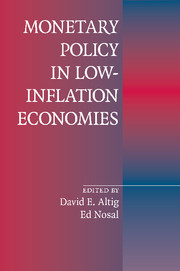Book contents
- Frontmatter
- Contents
- Contributors
- Acknowledgments
- Introduction
- 1 The Welfare Cost of Inflation in the Presence of Inside Money
- Commentary
- 2 An Open-Economy Model of Endogenous Price Flexibility
- Commentary
- 3 Efficient Inflation Targets for Distorted Dynamic Economies
- Commentary
- 4 Inflation and Welfare in Models with Trading Frictions
- Commentary
- 5 Good versus Bad Deflation: Lessons from the Gold Standard Era
- Commentary
- 6 Monetary Policy Orientation in Times of Low Inflation
- Commentary
- 7 Observations on Disinflation in Transition Economies
- Commentary
- 8 Inflation and Financial Market Performance: What Have We Learned in the Last Ten Years?
- Commentary
- Index
4 - Inflation and Welfare in Models with Trading Frictions
Published online by Cambridge University Press: 26 January 2010
- Frontmatter
- Contents
- Contributors
- Acknowledgments
- Introduction
- 1 The Welfare Cost of Inflation in the Presence of Inside Money
- Commentary
- 2 An Open-Economy Model of Endogenous Price Flexibility
- Commentary
- 3 Efficient Inflation Targets for Distorted Dynamic Economies
- Commentary
- 4 Inflation and Welfare in Models with Trading Frictions
- Commentary
- 5 Good versus Bad Deflation: Lessons from the Gold Standard Era
- Commentary
- 6 Monetary Policy Orientation in Times of Low Inflation
- Commentary
- 7 Observations on Disinflation in Transition Economies
- Commentary
- 8 Inflation and Financial Market Performance: What Have We Learned in the Last Ten Years?
- Commentary
- Index
Summary
INTRODUCTION
We study the effects of inflation in models with various trading frictions. Our economic environment is based on recent search-theoretic models of monetary exchange following Lagos and Wright (2005), in that trade takes place periodically in both centralized and decentralized markets. However, following Rocheteau and Wright (2005), we extend previous analyses of that framework in two ways. First, by endogenizing the composition of agents in the market, we analyze the extensive margin (the frequency of trade) and the intensive margin (the quantity exchanged per trade). Second, we study several alternative trading or pricing mechanisms, including bargaining (as in previous studies), but also competitive price taking and price posting. The main contribution here is as follows: In Lagos and Wright (2005), the welfare costs of inflation are found to be considerably higher than in previous estimates. But in Rocheteau and Wright (2005), we show qualitatively that this conclusion can depend critically on the assumed mechanism. Here we ask, how much? That is, we study the quantitative effects of inflation under the different mechanisms.
To do this, we present a version of the framework that is simple enough to take to the data, yet general enough to capture some of the key ideas discussed in the relevant literature. One such idea is that the frequency of trade should be endogenous. We use something like the standard matching function from equilibrium search theory to capture the time-consuming nature of trade and how it depends on the endogenous composition of agents in the market. Modeling the extensive margin explicitly is important because inflation may affect it differently than the way it affects output along the intensive margin.
- Type
- Chapter
- Information
- Monetary Policy in Low-Inflation Economies , pp. 89 - 116Publisher: Cambridge University PressPrint publication year: 2009
- 17
- Cited by

